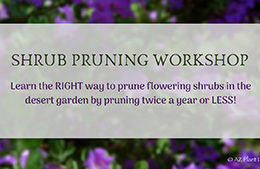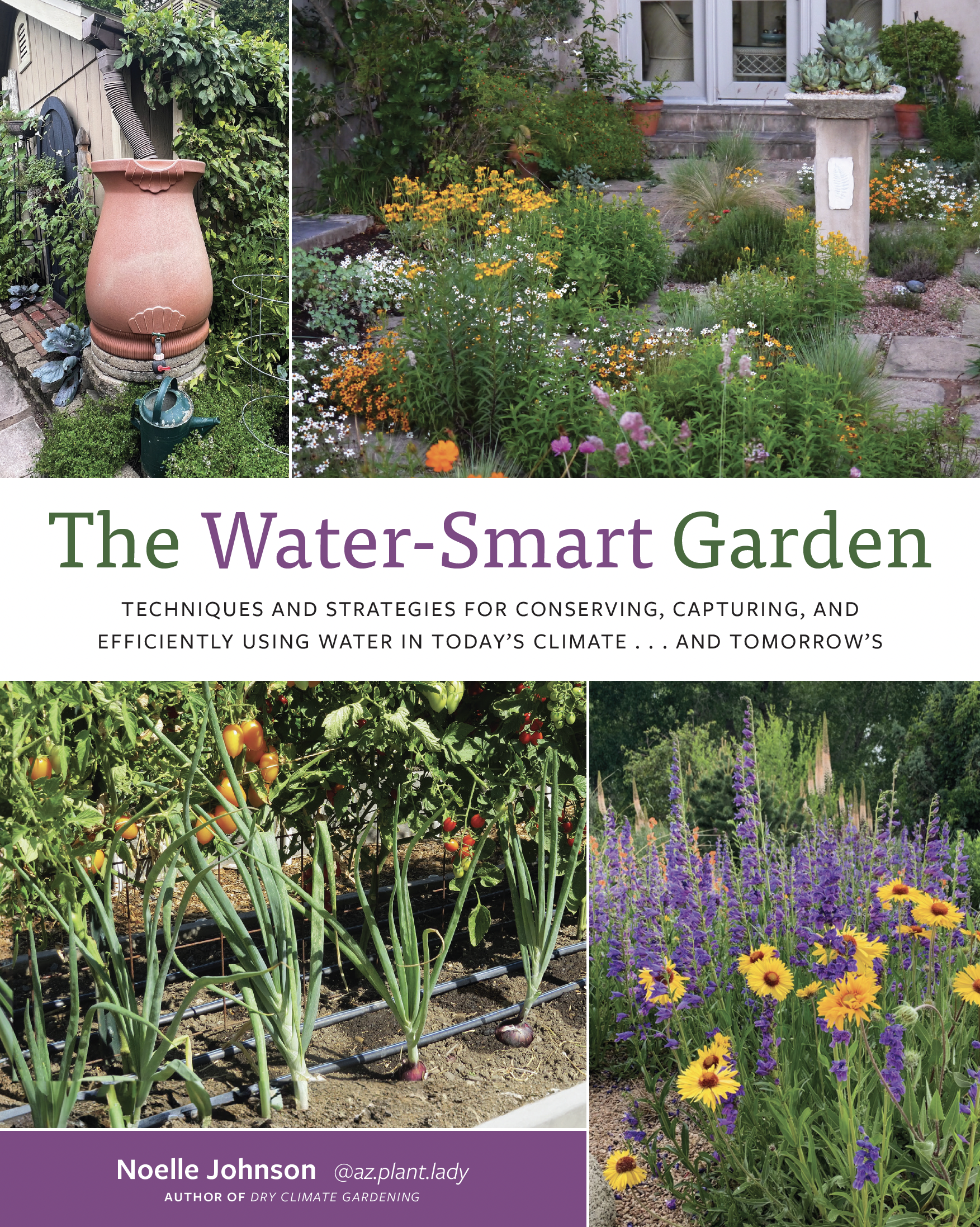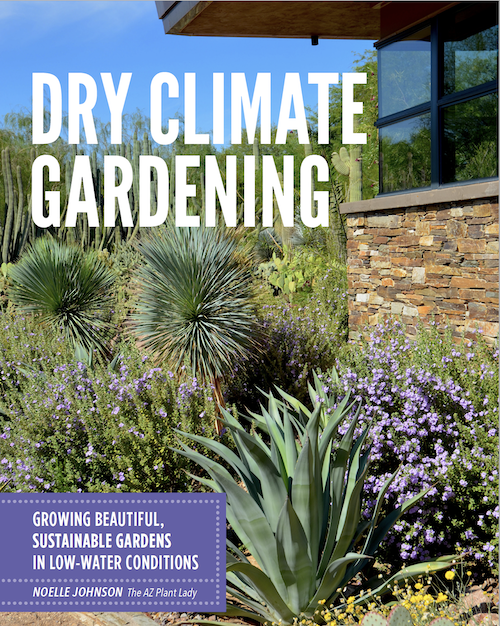This past week, I have been sharing with you my latest landscape project that is located next to a golf course.
I shared with you the tree and shrubs that I had chosen and not it’s time to show you what perennials and succulents that will be going in.
*All the following perennials are drought tolerant and require full sun with well-drained soil.
Perennials and Succulents
Damianita(Chrysactinia mexicana) is a fabulous flowering ground cover.
It thrives in locations with hot, reflected heat and handles cold temperatures (down to 0 degrees F) just as well.
In spring and again in fall, masses of bright yellow flowers cover this low-growing perennial. When not in bloom, it has dark green needle-like foliage.
Newly planted landscape with Purple Trailing Lantana, Parry’s Penstemon, Desert Spoon, Palo Blanco trees and Damianita.
I have used Damianita in other landscapes that I have designed in the past (shown above), with great results.
*The trick to keeping Damianita looking great is to shear it back in late spring.
Perennials and Succulents
Firecracker Penstemon(Penstemon eatoni) is my favorite flowering perennial. The one pictured above, is in my own garden.
I am often asked about this brilliantly colored plant in spring when it is in bloom.
One of the reasons that I love this Penstemon is that is begins flowering in winter, in zone 9b and continues on into spring. In cooler zones, it begins flowering in spring and lasts into summer. It handles cold temperatures easily and is hardy to zone 5.
Hummingbirds find the flowers irresistible. To prolong bloom, prune off the flowering stalks once the flowers begin to fade and you will be rewarded with another flush of bloom.
Perennials and Succulents
Angelita Daisies(Tetraneuris acaulis formerly, Hymenoxys acaulis) are what you could call one of my ‘signature’ plants, because I use them often, like the landscape I designed, above.
I find them invaluable in the landscape because they flower off and on throughout the year, with the heaviest bloom occurring in spring.
They easily handle full sun and reflected heat and look great in pots. I like to plant them next to boulders in groups of 3 or 5 for best effect. Cold temperatures are no problem either because they are hardy to zone 5.
Maintenance is easy – simply shear the flowers every 8 weeks or so.
Now, so far I have shown you the trees, shrubs and perennials planned for this area. But, I want to add succulent plants, which are also used as accent plants. These types of plants add texture to the landscape because their unique shapes contrast well with the softer, more rounded shapes of the shrubs and perennials.
Weber’s Agave(Agave weberi) is a large agave that can grow 5 to 6 ft. high and up to 8 ft. wide.
In large landscape areas, I don’t want to use small succulents because it will be hard to see them unless you mass a lot of them together. My budget won’t allow for that with this project.
I love how this large agave can stand up on its own. I like to plant flowering ground covers underneath them.
Plant in full sun or light shade. Weber’s Agave is hardy to zone 7. *Agave need supplemental water in our climate to look their best. I recommend watering twice a month in summer and once a month in spring and fall.
You can’t get much more unique in shape and coloring then Purple Prickly Pear(Opuntia santa-rita).
I love the gray pads with shades of purple.
The purple color deepens in cold temperatures or in times of drought.
In spring, yellow flowers cover this beautiful cactus.
Hardy to zone 8, plant in full sun and well-drained soil.
**If you notice white cottony masses on your prickly pear, simply spray it off with a hose. They are caused by an insect.
Okay, are you ready for my last plant selection for this new project?
It is hard to find a succulent that works harder then Red Yucca(Hesperaloe parviflora). Despite their common name, they aren’t a yucca.
The lower, succulent leaves resemble ornamental grasses. In spring coral-colored flowers are borne above the grass-like foliage.
Hardy to zone 7, Red Yucca thrives in full sun. While drought-tolerant, they do best with supplemental water.
Maintenance is easy – just remove the flowering stalks as they begin to fade.
*There is a common mistake that landscapers often make with this succulent plant. To make sure this doesn’t happen to you, check out my previous post, “Do This NOT That”.
The last element for my newest project isn’t a plant at all, but it adds height and texture to the landscape without requiring any water or pruning…
Boulders!
I will use boulders interspersed throughout this flat area to add height. The boulders will have either a succulent and/or flowering perennials planted next to them.
Well, I must say that I am excited to get started on this project. We will wait until this fall for the planting.
I’ll be sure to take you all along as it progresses.
***************************
7 days until my daughter, Rachele, comes home from the Navy!!!








Landscape “Do’s”
Landscape DesignWhen I am driving about town, I tend to look at the landscapes that I pass by. Usually, I tend to see some “landscape no-no’s”, which I like to share with you now and then.
But, I also take pictures of what I like to call “landscape do’s”. I realized the other day, that I tend to share with you bad examples of landscapes much more then the good ones, so here are a few that I saw the past couple of weeks…
I love Gold Lantana and how it flowers non-stop spring through fall. When planted next to boulders, you get a great contrast in textures.
What is even better about this arrangement, is how easy Lantana is to grow. Unlike many tropical climates, Lantana is not invasive in arid climates. Just water it regularly and prune it back hard in spring (6″ high), after the last frost. Periodically prune it back every 2 – 3 months, stopping pruning 3 months before the first frost date in your area.
Sometimes, I see great examples of desert trees that are properly pruned.
This Texas Ebony (Ebanopsis ebano formerly Pithecellobium flexicaule) is beautiful tree that is prized for its dark green foliage that is evergreen.
It does have thorns and gets seedpods, but it highly prized by those who live in the Southwest.
This nicely designed landscape was located next door to a house where I was visiting a client.
I like how the columnar cacti flank the entry on either side. Totem Pole (Lophocereus schotti ‘Monstrosus’) is on the left and has the bonus that it is thornless. Another favorite of mine, Mexican Fence Post (Pachycereus marginatus), which is one of the few cacti that I have in my own garden.
The yellows of the Golden Barrel (Echinocactus grusonii)with their rounded shapes contrast nicely with the spiky fans of Desert Spoon (Dasylirion wheeleri).
**Another bonus about this landscape is that it is extremely low-maintenance.
Scottsdale, Arizona
While stopped at an intersection in Scottsdale, Arizona, I noticed this distinctive landscaped area with contrasting spokes of a wheel fanning out from the sign.
Different sizes of gravel are often used to add interest to the landscape by the contrasts in size.
Agave and Aloe vera make up the plantings in the lighter colored spokes while Golden Barrel are used in the darker rip rap.
Well, these are just a small sampling of the “landscape do’s” that I have seen lately.
I hope you enjoyed seeing them and maybe will be inspired to replicate a couple of these plantings in your own landscape.
Golden Barrel Cacti – So Many Uses
What’s Wrong With This Landscape? – And The Answer Is…
AZ Plant LadyYesterday, in my latest “Landscape No-No” post, I asked you if you could figure out what was wrong with this landscape that I drove by earlier this summer.
I had some great guesses.
Here are a few of my favorites…
“The grasses are planted too closely together.”
“There are too many similarly-shaped plants.”
AND
“The large Pine tree is too large for this landscape and planted too closely to the wall where its can fall or its roots can cause damage.”
Well, they are all great answers and are correct. BUT, there is something else wrong with this landscape, which no one noticed.
Look closely at the two photos below…
Above, is Purple Fountain Grass (Pennisetum setaceum ‘Rubrum’).
It is a beautiful ornamental grass and is fine for this landscape.
BUT, notice the ornamental grass to the right with the cream-colored plumes.
Here is a closer view…
This grass is also called Fountain Grass, just without the ‘Purple’.
The problem with regular Fountain Grass (Pennisetum setaceum), is that while attractive – it is considered an invasive plant in many areas including the southern half of the United States and Hawaii.
Native to Africa and the Middle East, it spreads easily and is overtaking areas of the desert, outcompeting the native plants and grasses.
The reason that it’s a problem here is that it was widely planted in the mid 20th century. Unfortunately, that was before people knew it would become a problem.
In this landscape, the homeowners were probably thinking that they were planting the same type of grass as the Purple Fountain Grass (which is not invasive).
SO WHAT CAN BE DONE?
Well, removal is necessary and requires someone with a strong back to take it out.
A great alternative to Fountain Grass that looks even better is called ‘Gulf Muhly’ or ‘Regal Mist’ (Muhlenbergia capillaris ‘Regal Mist’).
It starts out green in spring and summer…
As fall approaches, burgundy-colored plumes begin to appear…
Once winter arrives, the plumes fade to an attractive wheat-color…
Maintenance is very easy – simply prune back to 6 inches in late winter/early spring.
**For more information on Fountain Grass, including on where it is found and how to manage it, click here.
I promise to show additional “Landscape No-No’s” and how to deal with them in the future.
AZ Plant Lady Drive By: What Is Wrong With This Landscape?
azplantladyOften, after I finish with a landscape consult, I drive through the neighborhood and capture examples of good and often bad landscaping.
I do this so that I can use these photos to help you to avoid mistakes in your own landscape.
So, what do you think is wrong with the landscape above?
Please leave your comments and I’ll give you the answer tomorrow….
Fuss Free Plants and TV Taping
Fuss Free PlantWhat if you could have a landscape filled with beautiful, flowering plants that needed pruning only once a year?
Better yet, what if these beautiful plants needed little to no fertilizer and thrived in our desert climate?
Would you want to include some of these plants in your garden?
A couple of weeks ago, I was asked by the producers of Sonoran Living, a locally produced lifestyle show, to show some ‘fuss free’ plants suitable for fall planting.
I shared a few of my favorites in my previous post, “Fuss Free Plants for Fall Planting”.
Today, I would like to show you the plants that I profiled on the show…
Coral Fountain
Coral Fountain (Russelia equisetiformis) has a lovely cascading form and produces vibrant red flowers spring through fall.
Maintenance: Prune back in March, removing frost-damaged growth.
Hardy to 15 degrees.
Plant in full sun or in light shade.
Desert Ruellia
Desert Ruellia (Ruellia peninsularis) is a medium-sized shrub with light green foliage and purple flowers that appear spring through fall. This shrub is a great alternative for Texas Sage because it does not grow as large.
Maintenance: Prune back to 1 1/2 ft. in early March. Avoid repeated pruning during the year. Allow it to grow into its natural shape.
Hardy to 25 degrees.
Plant in full sun and allow room for it to grow to its mature size of 4 feet wide.
‘Phoenix’ Bird-of-Paradise
Phoenix Bird-of-Paradise (Caesalpinia pulcherrima ‘Phoenix Bird’) is the yellow form of Red or Mexican Bird-of-Paradise (Caesalpinia pulcherrima). Gorgeous yellow flowers appear all summer long on these tropical shrubs.
Maintenance: Prune back to 1 ft. in winter.
Hardy to 15 degrees.
Plant in full sun, along a bare wall.
Blue Bells
Blue Bells (Eremophila hygrophana ‘Blue Bells’) is a relatively new plant introduction. Gray foliage is covered with blue/purple flowers off and on throughout the year.
Maintenance: Little to no pruning required.
Hardy to 17 degrees.
Plant in full sun and pair with shrubs with dark green foliage such as Valentine (shown below).
Valentine (Eremophila maculata ‘Valentine’) is a superstar in the landscape. The reason for this is its red flowers that appear all winter long and into spring. Better yet, the foliage is evergreen.
Maintenance: Prune back to 1 1/2 ft. high and wide in late spring, after flowering finishes. Don’t prune more then this or flowering will be reduced later in the year.
Hardy to 15 degrees.
Plant in full sun in groups of 3 to 5 for best effect. Pair with yellow flowering plants such as Angelita Daisy or Brittlebush.
Gopher Plant (Euphorbia rigid) is a uniquely shaped succulent that produces chartreuse flowers in spring.
Maintenance: Prune back flowers after they dry in late spring.
Hardy to -20 degrees.
Plant in groups of 3 around boulders.
I hope you enjoyed seeing some of my favorite ‘fuss free’ plants.
What are some of your favorite low-maintenance plants?
Fuss-Free Plants for Fall Planting
azplantladyDo you like spending hours pruning and fertilizing your plants? Or maybe you are tired of having to spend money on monthly visits from your landscaper.
What if you could have a landscape full of beautiful plants that only need pruning once a year and little to no fertilizer?
Now you may be thinking that I am talking about a landscape full of cacti and a rock or two like the photo below – but I’m not.
The key to selecting ‘fuss free’ plants is to choose plants that are adapted to our arid climate.
Here are a few of my favorite ‘fuss free’ plants that need pruning once a year or less…
Firecracker Penstemon
Firecracker penstemon (Penstemon eatoni) is great addition to any desert landscape. Its orange/red flowers appear in late winter and last through the spring. Hummingbirds find them irresistible.
Maintenance: Prune off the dead flower spikes in spring.
Hardy to -20 degrees.
Plant in full sun.
Damianita
Damianita (Chrysactinia mexicana) is a low-growing groundcover that is covered with tiny green leaves. Masses of golden yellow flowers appear in spring and again in the fall.
Maintenance: Prune back to 6″ in spring once the blooms have faded.
Hardy to 0 degrees.
Plant in full sun. Damianita looks great next to boulders or lining a pathway.
Gulf Muhly ‘Regal Mist’
Pink muhly(Muhlenbergia capillaris) is a fabulous choice for the landscape. This ornamental grass is green in spring and then covered in burgundy plumes in the fall.
Maintenance: Prune back to 3 inches once the threat of frost has passed.
Hardy to 0 degrees.
Plant in full sun in groups of 3 to 5. Pink muhly also looks great when planted next to large boulders or in straight rows in more contemporary designs.
Mexican Honeysuckle (Justicia spicigera)
Mexican honeysuckle(Justicia spicigera) is the perfect plant for areas with filtered shade. Tubular orange flowers appear off and on throughout the year that attract hummingbirds.
Maintenance: Little to no pruning required. Prune if needed, in spring once the threat of freezing temperatures has passed.
Hardy to 15 degrees.
Plant in filtered shade such as that provided by palo verde or mesquite trees. Add purple trailing lantana in the front for beautiful color contrast.
Baja Fairy Duster
Baja fairy duster (Calliandra californica) has truly unique flowers that are shaped like small feather dusters. The red flowers appear spring through fall and occasionally in winter.
Maintenance: Prune back by 1/2 in late winter, removing any frost damage. Avoid pruning into ’round’ shapes. Baja fairy duster has a lovely vase-shape when allowed to grow into its natural shape.
Hardy to 20 degrees.
Plant in full sun against a wall. Baja fairy duster can handle locations with hot, reflected heat.
Angelita daisy (Tetraneuris acaulis formerly, Hymenoxys acaulis) is a little powerhouse in the garden. Bright yellow flowers appear throughout the entire year.
Maintenance: Clip off the spent flowers every 3 months.
Hardy to -20 degrees.
Plant in full sun in groups of 3 around boulders. Pair with firecracker penstemon for color contrast. Thrives along walkways in narrow areas that receive full, reflected sun.
These are just a few ‘fuss free’ plants that you can add to your landscape this fall, which is the best time of year to add plants in the desert southwest.
**For more of my favorite ‘fuss free’ plants, check out my latest post.
Can You Recognize These Badly Pruned Plants?
AZ Plant LadyEarlier this week, I was stopped at an intersection when I noticed the sad plants on the corner.
I apologize for the poor-quality photo, but I only had a few seconds to take a picture with my phone through the window.
What was so sad about these plants was that they were mere shadows of themselves.
Many people would be hard pressed to recognize the over-pruned specimens above to what they look like when allowed to grow into their more natural shapes.
Here are photos of the same type of tree, taller shrub and cupcake shape shrub growing in happier circumstances…
The small mushroom-topped tree is actually a Palo Brea tree (Parkinsonia praecox), which has a beautiful shape. The trunk is beautiful as it twists upward.
Unfortunately, the flowering shrubs underneath it have fallen victim to over-pruning.
The taller shrub from the ‘sad’ plant photo is a Yellow (Mexican) Bird-of-Paradise (Caesalpinia mexicana).
It can be grown as a small tree or tall shrub.
Yellow flowers appear off and on throughout the year. However, I doubt that the over-pruned Yellow Bird-of-Paradise is ever able to produce a single flower before it is pruned off.
Can you believe that the cupcake-shaped shrub in the first photo is actually the same kind as this gorgeous flowering shrub?
Perhaps more then any other type of desert shrub, those that belong to the family Leucophyllum (often referred to as Texas Ranger or Sage) are pruned into balls, squares, cupcakes and even disks.
Unfortunately, due to a badly designed landscape, the lower shrubs don’t have enough room to grow. A single tree would have plenty of room to be able to grow, but not two.
A better plan would have been for there to be a single Palo Brea tree with 3 Texas Sage shrubs along the wall. The groundcover, Bush Morning Glory (Convolvulus cneorum) works okay in this area.
**You know what is interesting about this small piece of landscape and countless others? It would cost so much less if people would allow enough room for plants to grow to their full size, not to mention much more attractive.
There would be FEWER PLANTS to purchase, LESS WATER needed and far LESS MAINTENANCE required.
It makes you think about why people over-plant and over-prune, doesn’t it?
For more information on how to properly prune shrubs, check out my previous post, “The Good, The Bad and The Ugly”.
If you would like to see more badly pruned trees along with a link to how to properly prune trees, check out “Scary Pruning Practices and the Unfortunate Results.”
Family Celebrations
az plant lady family, azplantladyThe past few days have been full of celebration in our family. Our daughter has returned home from her Navy training AND we have a new addition to our family.
For those of you who have been following along in my adventures, you may remember that my second-oldest daughter, Rachele, joined the Navy last spring.
This was our last family photo taken just before she left in March.
We missed her a lot, but were proud of her decision. My husband and I, along with our oldest daughter traveled to Chicago back in May to see her graduate and I shared our journey with you back then.
Since then, Rachele has been in Missouri, training to be an equipment operator learning how to drive excavators, bulldozers, scrapers, semi-trucks, etc. She did very well and love it – I’m not sure where she got her skills (not from me 😉
Last week, she graduated and became a “Seabee”.
Okay, so what is a “Seabee”, you may be wondering. I know I did when she first told me that was what she would be doing.
Basically, a Seabee is a member of the Navy Construction Battalion. They build bases, airstrips and roads – sometimes in hostile territories. Unlike most members of the Navy, they spend little to no time on ships.
Once they graduate, Seabees trade in their traditional navy and blue camouflage uniform for “Seabee Greens”.
Last week, Rachele graduated and got the honor of wearing her “Seabee Greens”.
We were so proud and couldn’t wait for her to come home. She arrived late on Saturday night. We didn’t tell the kids when she was coming.
They were surprised when their big sister woke them up.
Rachele was happy that her cat remembered her.
The next day after church, we went to her favorite place for lunch.
That evening, we had all of the family over for dinner. Our home was filled with aunts, uncles, grandmas, cousins and siblings including my granddaughter…
Lily dressed up for the occasion.
I mentioned that we had an addition to our family.
I’d like for you to meet ‘Penny’…
Penny is the newest member of our furry family.
She is an 8-week old English Black Labrador Retriever.
There are two types of labradors – one is from English stock and the other, American. The English types are shorter, stockier and blockier.
Both are classified as labrador retriever by the AKC.
Needless to say, our days have been filled with frequent trips to the backyard as Penny works on becoming housebroken. And, our kitchen is filled with chew toys.
What to Do In The Southwest Garden – September
AZ Plant LadyI am so glad that September is finally here!
Oh, I realize that it is still hot, but if you look carefully, there are signs that summer is beginning to wane. The days are becoming shorter and you can see lengthening shadows at days end.
Fall is a busy time in the garden if you live in the desert Southwest, because that is the best time to add new plants to the garden.
Are you wondering what to do in your garden this month? Here is my latest garden article from Houzz.com
Southwest Gardener’s September Checklist
From Shabby Chic home décor to contemporary furniture and decorative mirrors, browse thousands of decorating ideas to inspire your next home project.
From wall paper to stencils for walls, upholstery fabrics to room dividers, design doesn’t stop at construction.
What are your plans for the garden this month?
**There is still time to enter the giveaway for a fabulous book, “Gardening for the Birds: How to Create a Bird-Friendly Backyard”.
I’ll announce the winner tomorrow!
DIY Stepping Stones and Border
DIYEarlier this month, I was visiting the garden of a homeowner while doing a consultation. The landscape was in great shape with healthy shrubs and trees. But, what kept catching my attention were the beautifully decorated blocks that made up the border.
The entire front landscape was bordered with uniquely decorated cement block, decorated with pieces of dishes, glass beads and more.
Every block was a unique creation.
While admiring the border, the homeowner told me that his wife had made this beautiful border using everyday items such as plastic food containers and cooking spray.
He offered to introduce her to me, so we headed into the house where I was greeted by more of her beautiful creations.
I love this welcome stone, don’t you?
Here is another decorated step stone…
I love the spiral pattern.
I was shown her workshop where she creates her works of art. You can see the plastic food containers and some dishes ready to be broken into small pieces.
The dishes were purchased at the local dollar store and the glass beads came from the craft store.
I asked her how she made them, so that I could share it with you.
Supplies: Mortar mix, a bucket, a trowel, plastic food container in desired size, cooking spray, broken pieces of dishes and glass beads.
1. Mix the mortar mix in a bucket with water until you have the consistency of brownie batter.
2. Spray the food container with cooking spray.
3. Add the cement mixture to the container to the top and smooth out with the trowel.
4. Now for the fun part – add pieces of dishes and/or beads to create your design. You could even use small pieces to spell out words.
5. Allow to dry for 48 hours.
6. Pop out and place in your garden!
You can buy plastic forms at your local craft store to create stepping stones, following the same steps above.
I thought it would be a fun way to create plant markers for the garden by using small food containers as forms.
I will undoubtedly be trying this in my own garden.
How about you? Have you ever created your own step stones or border?
**************************
I have two exciting new items to share with you…
The first is that my daughter, Rachele, graduated from her Navy Seabee school today.
She texted me a photo of her wearing her “Seabee Greens” for the first time. The Navy camouflage uniform is gray and blue, but when you are a “Seabee” you get to wear green.
I shared it on my facebook page if you would like to see it.
Rachele is coming home this weekend after 5 months away of training. Then she will be off to Mississippi for a month for more schooling (Expeditionary Combat Skills).
The best news is that she is going to be stationed in CA, just a 1/2 hour away from where I grew up!
For my second bit of news, I will share with you next time, but I’ll give you a hint – it involves television cameras…
Favorite DIY Posts – Day 3: Stepping Stones and Border
Plant Palette For New Landscape: Perennials and Succulents
AZ Plant Lady, Landscape DesignThis past week, I have been sharing with you my latest landscape project that is located next to a golf course.
I shared with you the tree and shrubs that I had chosen and not it’s time to show you what perennials and succulents that will be going in.
*All the following perennials are drought tolerant and require full sun with well-drained soil.
Perennials and Succulents
Damianita(Chrysactinia mexicana) is a fabulous flowering ground cover.
It thrives in locations with hot, reflected heat and handles cold temperatures (down to 0 degrees F) just as well.
In spring and again in fall, masses of bright yellow flowers cover this low-growing perennial. When not in bloom, it has dark green needle-like foliage.
Newly planted landscape with Purple Trailing Lantana, Parry’s Penstemon, Desert Spoon, Palo Blanco trees and Damianita.
I have used Damianita in other landscapes that I have designed in the past (shown above), with great results.
*The trick to keeping Damianita looking great is to shear it back in late spring.
Perennials and Succulents
Firecracker Penstemon(Penstemon eatoni) is my favorite flowering perennial. The one pictured above, is in my own garden.
I am often asked about this brilliantly colored plant in spring when it is in bloom.
One of the reasons that I love this Penstemon is that is begins flowering in winter, in zone 9b and continues on into spring. In cooler zones, it begins flowering in spring and lasts into summer. It handles cold temperatures easily and is hardy to zone 5.
Hummingbirds find the flowers irresistible. To prolong bloom, prune off the flowering stalks once the flowers begin to fade and you will be rewarded with another flush of bloom.
Perennials and Succulents
Angelita Daisies(Tetraneuris acaulis formerly, Hymenoxys acaulis) are what you could call one of my ‘signature’ plants, because I use them often, like the landscape I designed, above.
I find them invaluable in the landscape because they flower off and on throughout the year, with the heaviest bloom occurring in spring.
They easily handle full sun and reflected heat and look great in pots. I like to plant them next to boulders in groups of 3 or 5 for best effect. Cold temperatures are no problem either because they are hardy to zone 5.
Maintenance is easy – simply shear the flowers every 8 weeks or so.
Now, so far I have shown you the trees, shrubs and perennials planned for this area. But, I want to add succulent plants, which are also used as accent plants. These types of plants add texture to the landscape because their unique shapes contrast well with the softer, more rounded shapes of the shrubs and perennials.
Weber’s Agave(Agave weberi) is a large agave that can grow 5 to 6 ft. high and up to 8 ft. wide.
In large landscape areas, I don’t want to use small succulents because it will be hard to see them unless you mass a lot of them together. My budget won’t allow for that with this project.
I love how this large agave can stand up on its own. I like to plant flowering ground covers underneath them.
Plant in full sun or light shade. Weber’s Agave is hardy to zone 7. *Agave need supplemental water in our climate to look their best. I recommend watering twice a month in summer and once a month in spring and fall.
You can’t get much more unique in shape and coloring then Purple Prickly Pear(Opuntia santa-rita).
I love the gray pads with shades of purple.
The purple color deepens in cold temperatures or in times of drought.
In spring, yellow flowers cover this beautiful cactus.
Hardy to zone 8, plant in full sun and well-drained soil.
**If you notice white cottony masses on your prickly pear, simply spray it off with a hose. They are caused by an insect.
Okay, are you ready for my last plant selection for this new project?
It is hard to find a succulent that works harder then Red Yucca(Hesperaloe parviflora). Despite their common name, they aren’t a yucca.
The lower, succulent leaves resemble ornamental grasses. In spring coral-colored flowers are borne above the grass-like foliage.
Hardy to zone 7, Red Yucca thrives in full sun. While drought-tolerant, they do best with supplemental water.
Maintenance is easy – just remove the flowering stalks as they begin to fade.
*There is a common mistake that landscapers often make with this succulent plant. To make sure this doesn’t happen to you, check out my previous post, “Do This NOT That”.
The last element for my newest project isn’t a plant at all, but it adds height and texture to the landscape without requiring any water or pruning…
Boulders!
I will use boulders interspersed throughout this flat area to add height. The boulders will have either a succulent and/or flowering perennials planted next to them.
Well, I must say that I am excited to get started on this project. We will wait until this fall for the planting.
I’ll be sure to take you all along as it progresses.
***************************
7 days until my daughter, Rachele, comes home from the Navy!!!